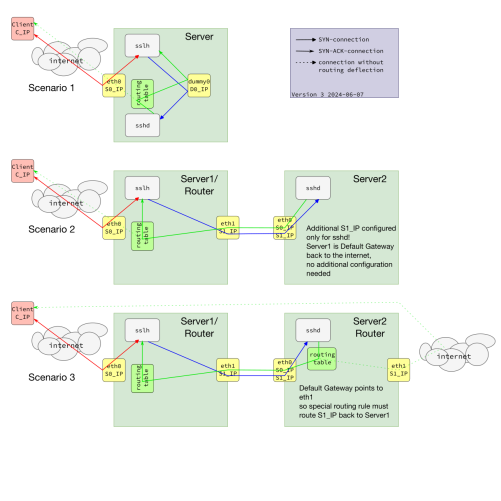Implementing Transparent Proxying on Linux Systems with sslh

Imagine you run a small business with several web services, such as a corporate website, an employee intranet, and a remote access server for staff working from home. Each service typically requires its port: 80 for the website, 443 for secure access, and 22 for SSH. Managing multiple ports complicates configuration and increases your exposure to security risks.
![]() A transparent proxy acts as a single entry point that intelligently directs incoming traffic to the right service based on the type of connection. This means you can have all your services neatly organized behind one port, simplifying network management and improving security. Let's explore how configuring
A transparent proxy acts as a single entry point that intelligently directs incoming traffic to the right service based on the type of connection. This means you can have all your services neatly organized behind one port, simplifying network management and improving security. Let's explore how configuring sslh, an SSL/SSH multiplexer for transparent proxying, can help achieve this streamlined setup.
What is sslh?
sslh is a powerful tool designed to multiplex protocols through a single port. It can intelligently redirect incoming packets to the appropriate backend service based on protocol characteristics. This versatility allows administrators to run multiple services on one port, making it an essential tool for efficient network management.
Noteworthy Features of sslh
- Protocol Probing: sslh can detect multiple protocols, including HTTP, HTTPS, SSH, OpenVPN, XMPP, and more.
- Support for Multiple Technologies: Works seamlessly with IPv4, IPv6, TCP, and UDP.
- Various Operating Modes: It can operate in fork mode, select mode, and libev mode, depending on your performance needs.
Importance of Transparent Proxying
Transparent proxying allows a proxy server to intercept client requests to the backend server without needing any special configuration on the client side. This proxy type is particularly useful for logging and maintaining visibility of the original client IP addresses in backend servers.
Use Cases
- Original Client IP Address Visibility: Provides backend servers with the original client's IP address, which is crucial for accurate logging and monitoring.
- Simplified IP-based Access Control: Since the original client addresses are preserved, access control policies are easier to manage.
- Enhanced Security Tools Integration: Improves the effectiveness of security tools like
fail2banby ensuring accurate IP address tracking.
Implementing Transparent Proxying on Linux
To implement transparent proxying on a Linux system using sslh, you can choose from a couple of practical methods: using virtual network interfaces or employing iptables for packet marking.
Method 1: Using Virtual Network Interfaces
The first method involves creating virtual network interfaces. This approach grants precise control and management of network traffic flows by segregating traffic interfaces for sslh. The process begins with configuring virtual network interfaces using commands like ip link add, which creates peer interfaces. Following this, specific routing rules are adjusted to ensure that traffic flows through these virtual interfaces, with sslh then being configured to bind to them. Although this method provides high control and detailed traffic management, it does require significant network configuration expertise.
Method 2: Using iptables Packet Marking
 The second method leverages
The second method leverages iptables for packet marking. This technique relies on setting iptables rules to mark packets based on predefined criteria, which are then redirected to the designated backend services. For instance, create a rule to mark incoming HTTP traffic with a unique identifier, which sslh will then use to route the traffic appropriately. This method allows for a flexible and dynamic setup that is suitable for more complex network architectures. However, it necessitates a thorough understanding of iptables syntax and firewall rule management since improper configuration can lead to network complications.
Both methods serve the ultimate goal of ensuring transparent proxying, where sslh intelligently routes traffic without requiring changes on client devices. By implementing either strategy, Linux and IT managers can better control their network traffic, preserve client IP addresses for accurate logging, and enhance overall system security.
Configuring sslh for Transparent Proxying
Configuring sslh for transparent proxying allows for managing multiple protocols over a single port, simplifying network service management and security. This involves setting up sslh to listen on a specific port and correctly forward incoming traffic based on its protocol type to the appropriate internal service. This section will guide you through the steps required to configure sslh for transparent proxying on a standard Linux system and within a Docker container, ensuring an efficient and secure network configuration.
General Configuration for Transparent Proxying
To configure sslh for transparent proxying on a Linux system, you must create or edit the /etc/sslh.cfg file. Below is a sample configuration:
# /etc/sslh.cfg
verbose: true;
# Listening on the machine's external IP address
listen:
(
{ host: "1.2.3.4"; port: "443"; }
);
# Forwarding HTTP and SSH traffic to local services
protocols:
(
{ name: "ssh"; host: "127.0.0.1"; port: "22"; },
{ name: "tls"; host: "127.0.0.1"; port: "443"; },
{ name: "openvpn"; host: "127.0.0.1"; port: "1194"; }
);
# Increase timeout for OpenVPN
timeout: 5;
transparent: true;
runas: "sslh";
For POSIX capabilities, run:
sudo setcap cap_net_bind_service,cap_net_raw+pe /usr/sbin/sslh
Then start sslh:
sudo systemctl start sslh
Docker Container Configuration for Transparent Proxying
To run sslh in a Docker container with transparent proxying, you can create a Dockerfile and an accompanying configuration file. Here's how to do it:
- Create a Dockerfile:
# Dockerfile
FROM debian:latest
RUN apt-get update && \
apt-get install -y sslh && \
apt-get clean
COPY sslh.cfg /etc/sslh.cfg
RUN setcap cap_net_bind_service,cap_net_raw+pe /usr/sbin/sslh
EXPOSE 443
CMD ["/usr/sbin/sslh", "-F", "/etc/sslh.cfg"]
- Create the
sslh.cfgfile:
# sslh.cfg
verbose: true;
# Listening on the machine's external IP address
listen:
(
{ host: "0.0.0.0"; port: "443"; }
);
# Forwarding HTTP and SSH traffic to local services
protocols:
(
{ name: "ssh"; host: "127.0.0.1"; port: "22"; },
{ name: "tls"; host: "127.0.0.1"; port: "443"; },
{ name: "openvpn"; host: "127.0.0.1"; port: "1194"; }
);
# Increase timeout for OpenVPN
timeout: 5;
transparent: true;
- Build and Run the Docker Container:
docker build -t sslh-transparent-proxy .
docker run --cap-add=NET_ADMIN --cap-add=NET_RAW -p 443:443 -d sslh-transparent-proxy
In the Docker setup, the container listens on 0.0.0.0:443 and forwards traffic internally. The --cap-add flags ensure the container has the capabilities for transparent proxying. This dockerized configuration makes it easy to deploy sslh transparently across various environments.
What Are the Benefits of Using Transparent Proxying with sslh?
Transparent proxying with sslh offers a range of benefits for network administrators and users looking to efficiently manage multiple protocols over a single port. By automatically detecting and routing incoming connections based on their protocol type, sslh simplifies the configuration of services such as SSH, HTTPS, and OpenVPN. This conserves valuable server resources by reducing the number of open ports required and enhances network security and operational flexibility. Below, we explore the key advantages of implementing transparent proxying with sslh in your network infrastructure.
Improved Security
Transparent proxying maintains the visibility of original client IP addresses at backend servers, which is crucial for accurate logging and monitoring. This improves the ability to track and respond to malicious activities.
Operational Advantages
Transparent proxying simplifies firewall rules and offers consistent network traffic analysis. It provides better integration with IP-based security tools like fail2ban, enhancing the overall security posture.
Real-World Applications and Use Cases
Case Study
Consider a mid-sized company that implemented sslh for transparent proxying to secure its SSH and HTTPS services. By preserving the original client IP addresses, it strengthened its logging mechanisms, enabling faster and more accurate detection of malicious activities. This implementation led to a significant reduction in unauthorized access attempts and streamlined its network traffic analysis processes.
IT Management Impact
For IT managers, transparent proxying with sslh aids in making strategic decisions by providing accurate and detailed logging data. This data is essential for network security audits and compliance with data protection regulations.
Enhancing Logging and Monitoring
By maintaining the visibility of the original client IPs, transparent proxying ensures logs are more comprehensive and accurate. This accuracy allows for better application of security policies and quicker identification of anomalies in network activities.
Keep Learning About Transparent Proxying
Transparent proxying with sslh significantly boosts network security by preserving original client IP addresses, simplifying access control, and enhancing logging accuracy. By implementing the methods described above, Linux and IT managers can secure their systems more effectively, making sslh an invaluable tool in their security arsenal.














